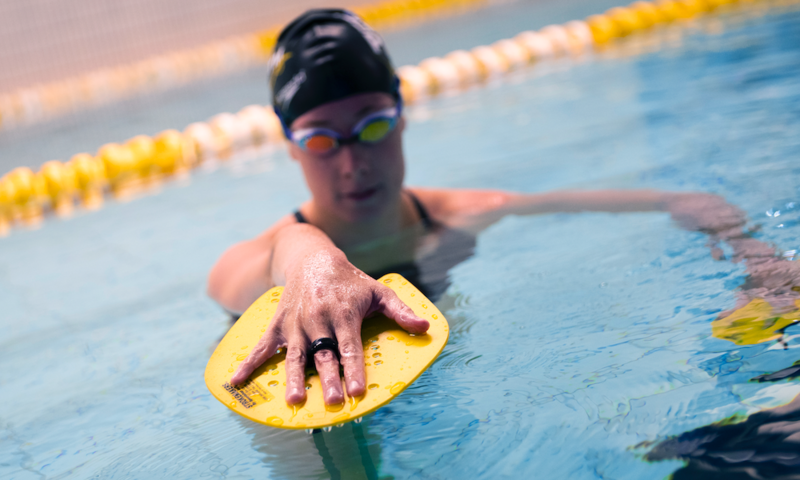Swimming blog - PULL and PULL-THROUGH How to improve your ‘feel for the water’
You might have heard that pro swimmers have a good ‘feel for the water’. What does that mean? How does water feel? Well wet, of course, but that is not what they are talking about. In this blog we will try to explain what that means and show you how to improve your feel for the water with some easy tips and exercises.
The water may feel differently at certain times. Funny isn’t it? Especially if you haven’t swum for a while, the water will feel like syrup: heavy and difficult to swim through. You may only be able to swim for a short time as your arms feel like lead ploughing through the water. It gets worse when speeding up. Sprinting feels like you are slipping in the water, not having any grip on it and you are sort of “wheel spinning”. Both these feelings are common and frustrating. On the other hand, swimming can sometimes feel like it’s coming together and you glide effortlessly through the water. You feel as if you can swim forever and increasing your pace is a peace of cake. This feeling draws us back to the water, time and again, because we can’t get enough of it.
The truth is, most to all swimmers have this varied experience of sometimes feeling the water and sometimes not. Pro swimmers have it less. Why is this? Because they swim often, focus on swimming drills, play around, take their time and aren’t scared to use paddles. Let’s have a look at each element separately.
SWIM (AT LEAST) TWICE A WEEK
The more you swim, the more feel for the water you create. We advise you to swim regularly, at least twice a week. This is the minimum to keep up a good feel for the water. Swimming twice a week will allow the neuromuscular pathways to form consistent patterns of behaviour which includes that “feel” for the water and how to manipulate our hands and arms to maximise propulsion. The more times you swim a week, the better it feels. In case of swimming: more is more! It is also important to vary your training routines. Doing the same thing over and over again doesn't do the trick. Mix up swimming intensities and work on different training goals to get out of your comfort zone and into effortless swimming. How? Check out our extensive database and find the perfect workouts to step up your game.
PRACTISE YOUR DRILLS
Want to get the neuromuscular pathways firing in a way that can sustain your newfound technique. Drills are the answer and a great way to improve your feel for the water. Sculling drills are probably the most effecitive drills to increase that ferel for the water. They allow us to feel the pressure of the water in the palm of our hands, forearms and upper arms. Drills also help us to how to position yourself in the water with the least resistance. When practising drills, make sure to take your time to focus on perfect execution. Never rush a drill, it will not benefit your swimming. Go slow to go fast. At swimgym.com we have great drills that will improve your feel for the water in no time. Go check them out.
PLAY AROUND
In this modern age, we think that we have to do things perfectly. But how do children learn? By making mistakes and playing. Playing is an important part of swimming and we forget that this is how really good swimmers became so good. Playing around is just that, goofing around. It adds an element of fun to what can seem a frustrating task of improving our feel for the water. Play around with your catch or pull-through. Go wide or deep, making the water feel heavy and needing more strength to push it. Swim with only two fingers or with fists, learning that a tensed open hand pushes away a lot more water. Playing around will feel funny and ‘wrong’, but it starts to create an awareness of your body and its position in the water.
CONNECT FIRST
Take your time and connect with the water when warming up. We see a lot of people swim way too fast and far in their warm-up, thinking that this will make them a better swimmer. In fact, it only makes you a tired swimmer. The warm-up is the perfect moment to go slow, get your breathing under control and feel the water moving over your body. Really try and be present and feel the water for what is, fluid and free. Use fins and a snorkel. Relax your stoke. No one is watching and you don’t need to swim a personal best in the warmup. Going slow in the warm-up also prevents shoulder injuries.

USE PADDLES
Paddles are a great way to give you a feel for the water. Due to the bigger surface area they allow us to feel the resistance of the water while pushing it back. Paddles are often used for building strength, but they are great tools for building technique and feel for the water too. There are a wide variety of paddles on the market from power paddles to technique paddles. Each one trying to achieve a different feel and feedback loop. Make sure to pick the right size for your hands and give it a try.
So the only question you might have left is, what does it feel like to have a 'feel for the water'? Here’s the answer: light yet firm. The lightness comes from a good catch and the firmness comes from the resulting grip on the water that translates into an accelerating pull-through. The ultimate moment of triumph is when you look up at the clock, see a quicker time for less effort. Then you have arrived!
